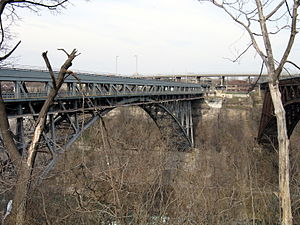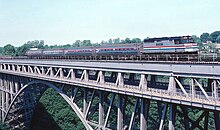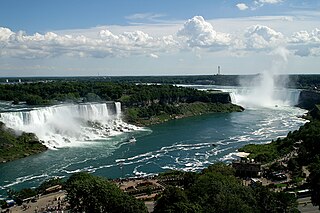
Niagara Falls is a group of three waterfalls at the southern end of Niagara Gorge, spanning the border between the province of Ontario in Canada and the state of New York in the United States. The largest of the three is Horseshoe Falls, which straddles the international border of the two countries. It is also known as the Canadian Falls. The smaller American Falls and Bridal Veil Falls lie within the United States. Bridal Veil Falls is separated from Horseshoe Falls by Goat Island and from American Falls by Luna Island, with both islands situated in New York.

The Maple Leaf is an international passenger train service operated by Amtrak and Via Rail between Pennsylvania Station in New York City and Union Station in Toronto via the Empire Corridor. Daily service is offered in both directions; the 544-mile (875 km) trip takes approximately 12 hours, including two hours for U.S. or Canadian customs and immigration inspection at either Niagara Falls, New York, or Niagara Falls, Ontario. Although the train uses Amtrak rolling stock exclusively, the train is operated by Via Rail crews while in Canada and by Amtrak crews in the United States. Service began in 1981.

The New York Central Railroad was a railroad primarily operating in the Great Lakes and Mid-Atlantic regions of the United States. The railroad primarily connected greater New York and Boston in the east with Chicago and St. Louis in the Midwest, along with the intermediate cities of Albany, Buffalo, Cleveland, Cincinnati, Detroit, Rochester and Syracuse. New York Central was headquartered in New York City's New York Central Building, adjacent to its largest station, Grand Central Terminal.

The Empire Service is an Inter-city rail service operated by Amtrak within the state of New York in the United States. The brand name originated with the New York Central Railroad in 1967. Trains on the line provide frequent daily service along the 460-mile (740 km) Empire Corridor between New York City and Niagara Falls via Albany, the state capital.
The Pere Marquette Railway was a railroad that operated in the Great Lakes region of the United States and southern parts of Ontario in Canada. It had trackage in the states of Michigan, Ohio, Indiana, and the Canadian province of Ontario. Its primary connections included Buffalo; Toledo; and Chicago. The company was named after Jacques Marquette, a French Jesuit missionary who founded Michigan's first European settlement, Sault Ste Marie.
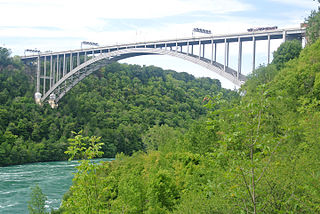
The Lewiston–Queenston Bridge, also known as the Queenston–Lewiston Bridge, is an arch bridge that crosses the Niagara River gorge just south of the Niagara Escarpment. The bridge was officially opened on November 1, 1962. It is an international bridge between the United States and Canada. It connects Interstate 190 in the town of Lewiston, New York to Highway 405 in the community of Queenston, Ontario. The Lewiston–Queenston Bridge is a twin of the Rainbow Bridge at Niagara Falls and designed by Richard Lee.
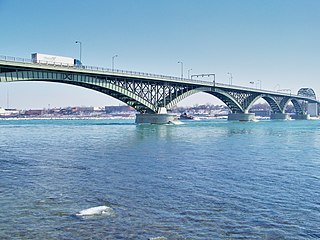
The Peace Bridge is an international bridge between Canada and the United States at the east end of Lake Erie at the source of the Niagara River, about 20 kilometres (12.4 mi) upriver of Niagara Falls. It connects Buffalo, New York, in the United States to Fort Erie, Ontario, in Canada. It is operated and maintained by the binational Buffalo and Fort Erie Public Bridge Authority.
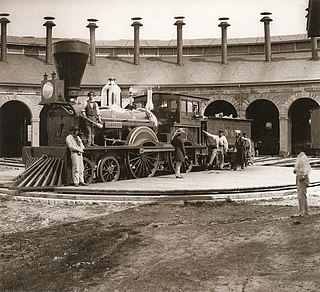
The Great Western Railway was a railway that operated in Canada West, today's province of Ontario, Canada. It was the first railway chartered in the province, receiving its original charter as the London and Gore Railroad on March 6, 1834, before receiving its final name when it was rechartered in 1845.

The Michigan Central Railroad was originally chartered in 1832 to establish rail service between Detroit, Michigan, and St. Joseph, Michigan. The railroad later operated in the states of Michigan, Indiana, and Illinois in the United States and the province of Ontario in Canada. After about 1867 the railroad was controlled by the New York Central Railroad, which later became part of Penn Central and then Conrail. After the 1998 Conrail breakup, Norfolk Southern Railway now owns much of the former Michigan Central trackage.

The Niagara Cantilever Bridge or Michigan Central Railway Cantilever Bridge was a cantilever bridge across the Niagara Gorge. An international railway-only bridge between Canada and the United States, it connected Niagara Falls, New York, and Niagara Falls, Ontario, located just south of the Whirlpool Bridge, and opened to traffic in 1883, it was replaced by the Michigan Central Railway Steel Arch Bridge in 1925.

The Niagara Falls Suspension Bridge stood from 1855 to 1877 across the Niagara River and was the world's first working railway suspension bridge. It spanned 825 feet (251 m) and stood 2.5 miles (4.0 km) downstream of Niagara Falls, where it connected Niagara Falls, Ontario to Niagara Falls, New York. Trains used the upper of its two decks, while pedestrians and carriages used the lower. The bridge was the idea of Canadian politicians, and it was built by an American company and a Canadian company. It was most commonly called the Suspension Bridge, although other names included Niagara Railway Suspension Bridge, Niagara Suspension Bridge, and its official American name of the International Suspension Bridge.
The Buffalo and Niagara Falls Railroad was a part of the New York Central Railroad system, connecting Buffalo, New York to Niagara Falls. It is still used by CSX for freight and Amtrak for passenger service.

Niagara Falls station is a railway station in Niagara Falls, Ontario, Canada. It is served by the Maple Leaf train between Toronto and New York City and is the terminus of GO Transit's Lakeshore West line towards Toronto. The Gothic Revival station building, which was built in 1879 by the Great Western Railway, is a designated heritage railway station. It is also listed on the Canadian Register of Historic Places.

The Great Gorge Route or Niagara Belt Line was an interurban trolley belt line encompassing the Niagara Gorge, operated by the International Railway and Niagara Gorge Railroad. Many dignitaries rode this line and they used to use a flat car with search light to illuminate the Niagara Whirlpool at night.

Niagara Falls station is a former Amtrak railroad station in Niagara Falls, New York. Operating from 1978 to 2016, it was replaced by the current Niagara Falls station. During its time, it was the western end of the Empire Corridor and served the Empire Service, Maple Leaf, and Niagara Rainbow lines.

The Michigan Central Railway Bridge is an out-of-service steel Deck arch bridge spanning the Niagara Gorge between Niagara Falls, Ontario and Niagara Falls, New York. The bridge is owned by Canadian Pacific Kansas City, which purchased the single track structure in 1990. The Canadian corridor and bridge are owned by the City of Niagara Falls, Ontario. The bridge is located just upstream from the older arch-style Whirlpool Rapids Bridge used by Maple Leaf Amtrak passenger trains.

The Niagara Gorge Railroad was an interurban railway which ran at the bottom of the Niagara Gorge from Niagara Falls, New York to Lewiston, New York.

A street running train is a train which runs on a track built on public streets. The rails are embedded in the roadway, and the train shares the street with other users, such as pedestrians, cars and cyclists, thus often being referred to as running in mixed traffic or sharing the road with trains. For safety, street running trains travel more slowly than trains on dedicated rights-of-way. Needing to share the right-of-way with motor vehicles can cause delays and pose a safety risk.

The Niagara Falls Station and Customhouse Interpretive Center is an intermodal transit complex in Niagara Falls, New York. It serves Amtrak trains and Niagara Frontier Transportation Authority buses, houses U.S. Customs and Border Protection offices servicing the Canada–United States border, and houses the Niagara Falls Underground Railroad Heritage Center.

The Niagara Rainbow, known as the Empire State Express before 1976, was an American passenger train service operated by Amtrak between New York City and Detroit via Buffalo and Southwestern Ontario in Canada. The service ran between October 31, 1974, and January 31, 1979.
